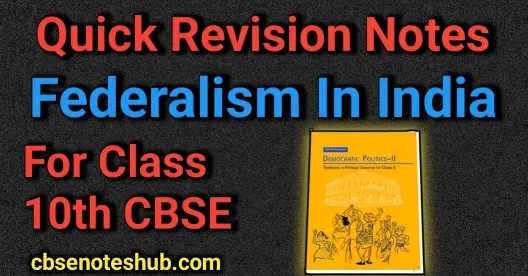Federalism in India Class 10 takes a deeper turn in this second part of the chapter. After understanding the core concept of federalism in Part 1, it’s time to explore how this system works in our country — from the division of powers between different levels of government to the special status of certain states and the role of the judiciary. This section is essential for every CBSE student aiming to build strong conceptual clarity and write impressive answers in exams.
Quick Revision Notes
Chapter – 2
Federalism Part – 2
What makes India a federal country?
Article 1: The constitution declares India a Union of States.
It did not use the word federation.
But Indian Union is based on the principles of federation.
The constitution originally provided for two tiers of government:
- Central govt.
- State govt.
Later, a third tier of federalism was added in the form of Panchayats and Municipalities in the 73rd schedule (73rd Amendment Act of 1992).
There are three lists of subjects mentioned:
Union List:
- Subjects of national interest
- Only Union/Central govt can make laws
- Defence, foreign affairs, banking, currency, communication
State List:
- Subjects of state interest (local interest)
- Only state govts can make laws
- Police, trade, agriculture, irrigation
Residuary List: New subjects like computers and subjects that do not fall in any of the three lists.
Only Union govt can make laws.
Examples: Computer technology, hardware, software, internet regulation
All states of Indian Union do not have identical powers.
States having special powers under certain provisions of the Constitution of India (Article 371):
Nagaland, Assam, Arunachal Pradesh, and Mizoram – because of their peculiar social and historical circumstances.
These special laws are for the protection of:
- Land rights of indigenous people
- Their culture
- Preferential employment in government services
Indians who are not permanent residents of these states cannot buy land or house there.
Some units enjoy very little power – (Union Territories)
Examples: Chandigarh, Lakshadweep, capital city of Delhi, etc.
The central govt has special powers in running these areas. (UTs)
Power-sharing arrangement of India cannot be changed easily
- Any change to this arrangement has to be first passed by both the Houses of Parliament with at least two-thirds majority.
- Then it has to be ratified (sanctioned) by the legislatures of at least half of the total states.
In India, the judiciary plays an important role when disputes arise about the division of powers.
In India, both Union and State govts. have the power to levy taxes and raise resources to meet their financial requirements.
Features of Indian Federalism
- Three-tier system:
- Union List
- State List
- Concurrent List
- Residuary List
- Special status to some states → Nagaland, Assam, Arunachal Pradesh, and Mizoram
- Smaller units enjoy limited powers (UTs) → Chandigarh, Delhi
- Independent Judiciary
If you’re revising multiple chapters together, don’t forget to check out our notes on another important topic from Class 10 Social Science – Development. It offers concept-based clarity with simple explanations, perfect for exam preparation and quick revision.
Let’s now go through some frequently asked questions based on this topic. These questions are commonly seen in CBSE exams and will help you revise key points quickly and effectively.
Q1. What does Article 1 of the Indian Constitution declare?
A. Article 1 declares India as a Union of States.
Q2. How many tiers of government did the Constitution originally provide?
A. Two tiers – Central government and State government.
Q3. Which amendment added the third tier of government?
A. The 73rd Amendment Act of 1992.
Q4. What are the three lists of subjects in the Indian federal system?
A. Union List, State List, and Residuary List.
Q5. Who can make laws on subjects in the Union List?
A. Only the Union/Central government.
Q6. Give one example of a subject in the Union List.
A. Defence.
Q7. Who can make laws on subjects in the State List?
A. Only the state governments.
Q8. Give one example of a subject in the State List.
A. Agriculture.
Q9. Who has the power to legislate on Residuary subjects?
A. The Union government.
Q10. Name one example of a Residuary subject.
A. Computer technology.
Q11. Which article gives special powers to some states?
A. Article 371.
Q12. Name any one state that has special powers under Article 371.
A. Nagaland.
Q13. Can Indians from other states buy land in special-status states?
A. No, only permanent residents can.
Q14. What is the status of Union Territories in terms of power?
A. They have very little power; the central government controls them.
Q15. Name any one Union Territory.
A. Delhi.
Q16. Who has to approve changes in power-sharing arrangements?
A. Both Houses of Parliament and at least half of the state legislatures.
Q17. Who resolves disputes between Union and State governments ?
A. The judiciary.
Q18. Who can levy taxes in India?
A. Both Union and State governments
Q19. Name the four types of lists in Indian Federalism.
A. Union List, State List, Concurrent List, and Residuary List.
Q20. What is the role of the judiciary in Indian federalism?
A. It settles disputes related to the division of powers.
Let’s Wind It Up
In this second part of Federalism in India Class 10, we explored how the Indian Constitution establishes a three-tier system, distributes powers across levels, and ensures unity through diversity. The special provisions for some states, limited powers for Union Territories, and the independent role of the judiciary make India’s federal structure both flexible and strong. For more chapters, revision notes, and exam-ready answers, do visit CBSE Notes Hub — your one-stop solution for Class 10 Social Science preparation.


